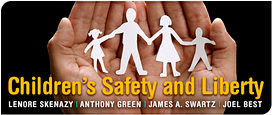Ms. Skenazy must have fun making these cavernous rhetorical leaps—e.g. that anybody would propose that a mom should be arrested for allowing a child to read Mad magazine—but that’s not what’s disturbing. If even one parent would relax their diligence because of her writing, that’s not good.
What’s really troubling about Ms. Skenazy’s argument is her use of the kind of cost-benefit analysis that industry uses in designing a toaster oven—a company should only make more costly design changes if a certain number of fires are caused or if a certain number of individuals are seriously injured.
Her math is as mind-boggling and as tiresome as her wisecracks. A formula that defines when children can be protected is extreme. The bottom line of it is this: because only 31 kids were left in cars and died of heatstroke, she argues, the problem doesn’t deserve attention. As Mr. Swartz asked in his essay, under “World’s Worst Mom” philosophy, how many kids have to die or suffer serious injury before government can step with its proven, measurable record of success at saving lives?
On the heatstroke danger, no law or regulation over “parental choice” is proposed, as Ms. Skenazy improperly says. Rather, we hope that education and awareness will cut down those fatality numbers, and the unknown number of near misses. Awareness gives parents the choice to be safer.
As I argued in my last post, the trickle-down theory of safety is wrong and cruel. It suggests that when a big, big, big problem is cured, safety educators search for smaller and smaller risks to stay in business. Thus Skenazy jumps from the Pintos of the 1960s to the ears on a Batman toy.
But this is not the path child safety has taken.
- In 2010, 4,077 kids 19 and under died in motor vehicle–related incidents.[1]
- In 2010, more than 400,000 children were nonfatally injured in motor vehicle–related incidents.[2]
- In 2009, 824 children aged 19 and under died from unintentional poisoning.[3]
- Each year, more than 3.5 million children ages 14 and under receive medical treatment for sports injuries—that includes concussions, a problem causing many parents intense anxiety.[4][5]
- From 1987 to 2009, suffocation and choking fatalities have risen from 771 deaths to 1,160.
They are big numbers, but it’s not all bad news. From 1987 to 2009, there has been over a 53 percent decrease in the unintentional injury death rate among children ages 19 years and under in the United States.[6] This doesn’t mean that our concern about child safety should be relaxed. It means that twenty-five years of action based on data and research has made kids safer. And that the journey is far from over.
I don’t like statistics, which may seem surprising given the number of numbers in the foregoing post; I prefer to put a face on the numbers. On Christmas 2011, embers from a fireplace started a house fire in Stamford, CT. The mother of the house was able to get out through a window, and screamed for help. Her parents and three daughters, a set of 7-year-old twins, Grace and Sarah, and Lily who was 9, were trapped behind a wall of flames. All five died, including the grandfather who tried to rescue at least one of them. Because the home was undergoing renovations, there were no smoke detectors in the home, and firefighters said they could have prevented this Christmas tragedy. We at Safe Kids work with firefighters on education across the nation on the need for smoke detectors. The Kidde Fire Sentry smoke and fire alarm is $7.99 on amazon.com. Do the math on that.
Notes
[1] National Highway Traffic Safety Administration. Fatality Analysis Reporting System (FARS) Encyclopedia. http://www.nhtsa.gov/FARS.
[2] National Highway Traffic Safety Administration. Personal communication with Lorenzo Daniels. Washington, DC: U.S. Department of Transportation; June 2012.
[3] Centers for Disease Control and Prevention, National Center for Injury Prevention and Control. Web-based Injury Statistics Query and Reporting System (WISQARS), http://www.cdc.gov/injury/wisqars/index.html.
[4] American Academy of Orthopedic Surgeons. “Play It Safe.” Rosemont, IL: American Academy of Orthopedic Surgeons, 1999.
[5] American Academy of Orthopaedic Surgeons. A guide to safety for young athletes. American Academy of Orthopaedic Surgeons Website, http://orthoinfo.aaos.org/topic.cfm?topic=A00307.
[6] Centers for Disease Control and Prevention, National Center for Injury Prevention and Control. Web-based Injury Statistics Query and Reporting System (WISQARS). http://www.cdc.gov/injury/wisqars/index.html.

